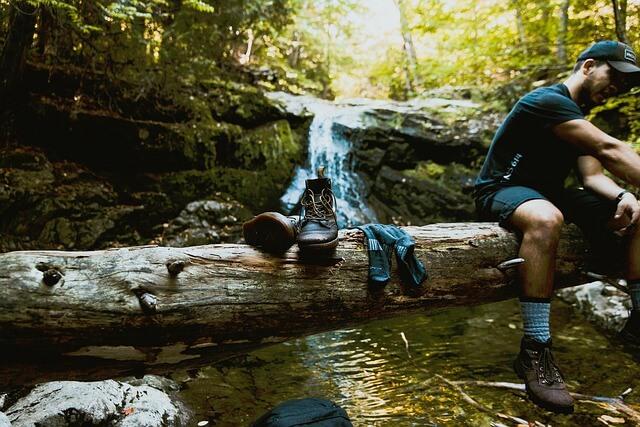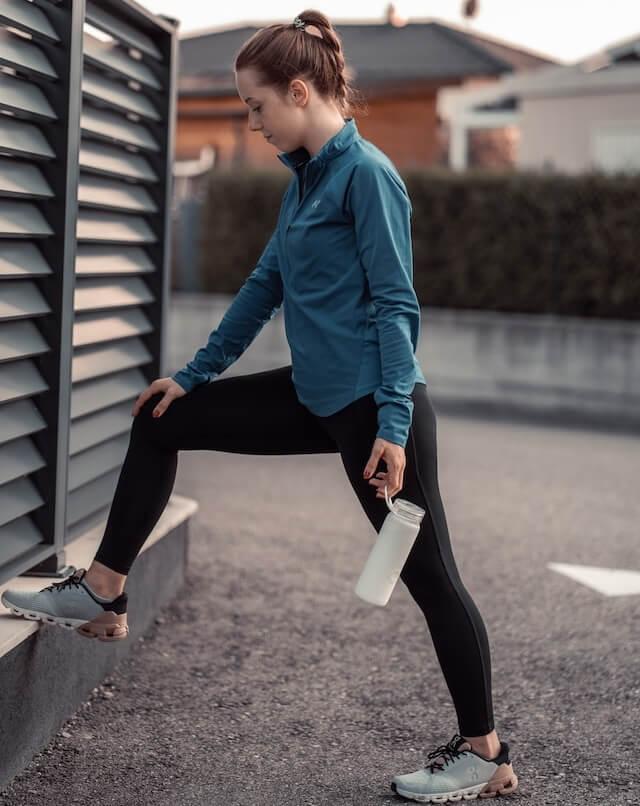If you’re looking for a way of getting amongst nature, blowing away the metaphorical cobwebs, getting some exercise, and improving your mood simultaneously, hiking is one of the best pastimes you can imagine.
Regardless of the time of year, the weather, or your location, hiking is a hugely popular activity that provides heaps of benefits. It’s also an activity which you must give the respect it deserves. When hiking, you must ensure you’re well prepared. This is important not only for your enjoyment of the activity, but also for your health and safety.

People hike in all types of conditions, in different weather, and on different terrain. Therefore, wearing the right clothing is absolutely critical. When hiking you need to be comfortable, but at the same time, you also need to be protected against the elements.
To help you stay safe while hiking, and to ensure you have the best possible time, here’s a look at several recommended items of what to wear when hiking.
Lower body
To ensure that your lower body is as comfortable and as well protected as possible when hiking, here are some lower body essentials.
Hiking boots
First and foremost, if you’re thinking of getting into hiking, you need to invest in a good quality pair of hiking boots.
Hiking boots are essential for hiking for multiple reasons. They offer waterproofing to help keep your feet dry, they offer more support and comfort, and they offer more grip so you’re less likely to slip or trip, regardless of the type of terrain you’re hiking on.

When choosing hiking boots, just be aware that they take a while to break in, so don’t be alarmed if they’re not the most comfortable boots you’ve ever worn when you try them on for the first time. you should therefore break them in before you use them on longer, more complex hikes.
While you can get general all-purpose hiking boots, if you are planning on hiking on trails that are particularly wet, muddy, and slippery, you should look at hiking boots made specifically for wet trails.
Hiking socks
Hiking/walking socks are also very important when it comes to hiking, so be sure to choose wisely when selecting socks for your next hike.
Having a good quality pair of walking socks is not only important for keeping your feet warm and ideally dry in cold and/or damp conditions, they’re also important for protecting against blisters. Blisters are to hikers what Kryptonite is to Superman. All it takes is one blister to ruin your hike, and your feet in general.

A good quality thick pair of hiking socks will help ensure you don’t suffer from painful rubbing or blisters, and they’ll also keep your feet warm in the winter.
When choosing socks for your next hiking trip, stay well away from cotton. Cotton is very absorbent, which means that it’ll soak up any sweat or moisture and become soggy and uncomfortable. Instead, look for hiking socks that wick away sweat, but still allow your feet to breathe at the same time.
Base thermal leggings
Base layers when hiking, are important for comfort and warmth, and thermal leggings are therefore ideal.
Thermal leggings worn under your trousers (more on those shortly) are great for helping to regulate your temperature, while also helping to wick away sweat and moisture, and prevent painful chaffing.

Thermal leggings are lightweight and stretchy, so they don’t restrict movement, and they also provide an added layer of protection against insects, sharp rocks, thorns, sticks, and other environmental dangers you might encounter while out on the trail.
Hiking trousers
A good quality pair of hiking trousers are also very much required before embarking on a long hike.
Hiking trousers have been specifically designed with hiking in mind, so don’t cut corners and assume a simple pair of sweatpants will suffice, because they won’t.

Hiking trousers are great as they’re stretchy and comfortable so as to not hinder your mobility. They also provide plenty of storage options by featuring plenty of pockets, plus they also offer some varying levels of water resistance. They’re also made from thicker fabric so they protect against bugs, insects, sharp objects, and other hazards that Mother Nature may toss your way.
For hiking in wet weather, or on trails featuring streams, lakes, rivers, or water in general, you should also purchase some waterproof trousers. You can also pack waterproof over-trousers, that you can simply slip on over your regular hiking trousers if things turn wet.
Gaiters
Finally for your lower body, we have gaiters.
Gaiters are often overlooked by amateur hikers or seen as overkill, when in reality they’re hugely beneficial.

Hiking gaiters are worn over the bottom of your trousers and the top of your boots to help ensure that no water, mud, dirt, insects, or any other debris can find its way inside your boots, which would be very uncomfortable to say the least. In the winter, they’ll also help to keep your ankles that little bit warmer and dryer too.
Upper Body
We’ve looked at several hiking essentials needed for the lower body, so now it’s time to focus on your upper body.
Hiking shirts
When hiking, the type of shirt you wear will very much depend on the weather, the conditions, and the terrain you’re hiking in.
Short sleeved shirts for example, are useful in the summer for helping to keep you cool, but the main downside to these is the fact that your arms are exposed, leaving you vulnerable to insects and other environmental hazards.

Long sleeved shirts are useful for keeping you warmer in cooler weather, plus they offer you more protection on the arms. Whether you’re wearing a long-sleeved shirt or a short sleeved shirt however, you must ensure that you choose a material which wicks away moisture.
Look for a shirt which wicks away moisture such as sweat, while also offering UPF (Ultraviolet Protection Factor) protection from the sun’s rays. Sunburn and/or heatstroke when hiking can be fatal, so take no risks when hiking in hot weather.
As far as materials go, in the winter you could go for Merino wool shirts, which are fantastic for insulating you while wicking away sweat and moisture. In the summer, cooler synthetic materials such as polyester are great choices.
A base layer
Staying warm when hiking is very important. Many hiking trails are found in locations where the weather can be extreme, and can change very quickly, so staying warm is essential. Hypothermia can set in very quickly and can be fatal. This is why a base layer under your regular hiking clothing is so important.

Look for a quick drying base layer with plenty of wicking as this will help keep you warm, regulate your body temperature, and help to keep you dry.
Waterproof jacket
Without sounding like a broken record, staying warm and dry while hiking should be one of your main priorities. This is where a waterproof jacket comes in so handy.

The type of jacket you wear while hiking will depend on numerous factors, including the weather, the terrain, the time of year, and your overall levels of comfort.
Most hikers will choose a jacket that’s waterproof and windproof, which is also easy to pack away so you can remove it or put it on as and when required. You should also look for a jacket that is not too heavy, not too restrictive, and is breathable for times when you may find yourself getting warm.
Hat
Hats are another item of clothing that, despite being very important for hikers, are also regularly overlooked.
Hats are most important in the summer and in the winter, for very different reasons.

In the summer, hats are needed to help keep the sun out of your eyes, to protect your head and face from the sun’s rays, and to also help prevent sweat from getting in your eyes. In the winter, thicker hats designed to insulate the head are important because they’ll help keep your head warm and prevent heat from being lost from the head.
Miscellaneous
Before we wrap things up for the day, here are a couple of miscellaneous hiking essentials you might not have considered.
Sunglasses
Sunglasses are important, not only for protecting your eyes in bright sunlight, but also for ensuring you remain safe on your hike and that you don’t accidentally stray from the trail because you couldn’t see the path properly.
When possible, choose polarizing sunglasses with a head strap so they don’t fall off your head when you’re on uneven terrain.
Gloves
Gloves are especially useful when hiking in the winter as they’ll help keep your hands warm, and also offer a little extra grip on slippery surfaces too.
When hiking in colder, wetter weather during the winter, thermal waterproof gloves are the way to go.
Underwear
Wearing the right type of underwear is also important for your comfort while hiking.
Ideally, find snug-fitting underwear made from a synthetic material that allows the skin to breathe, while also wicking away moisture and keeping you warm.
Frequently Asked Questions
Q: Can I wear cotton clothes for hiking?
A: It’s not recommended to wear cotton clothing for hiking. Cotton retains moisture and takes longer to dry, leading to discomfort and increased risk of hypothermia. Instead, choose moisture-wicking and quick-drying synthetic or merino wool materials that keep you dry and regulate body temperature. These fabrics enhance comfort and performance on the trail, unlike cotton.
Q: Do I need specialized hiking pants?
A: While not mandatory, specialized hiking pants offer advantages over regular pants. Designed with durable and stretchable materials, hiking pants provide comfort and flexibility. They often have water and stain-resistant properties, reinforced knees, and multiple pockets. Convertible hiking pants with zip-off legs offer versatility. While you can hike in regular pants, investing in hiking pants enhances your experience.
Q: Should I wear sunscreen when hiking?
A: Absolutely! Protect your skin from harmful UV rays by wearing sunscreen when hiking. Apply a high SPF, broad-spectrum sunscreen to all exposed skin and reapply regularly. Consider wearing a wide-brimmed hat, sunglasses, and clothing with UPF for additional sun protection. Safeguarding your skin prevents sunburns, premature aging, and reduces the risk of skin cancer.









